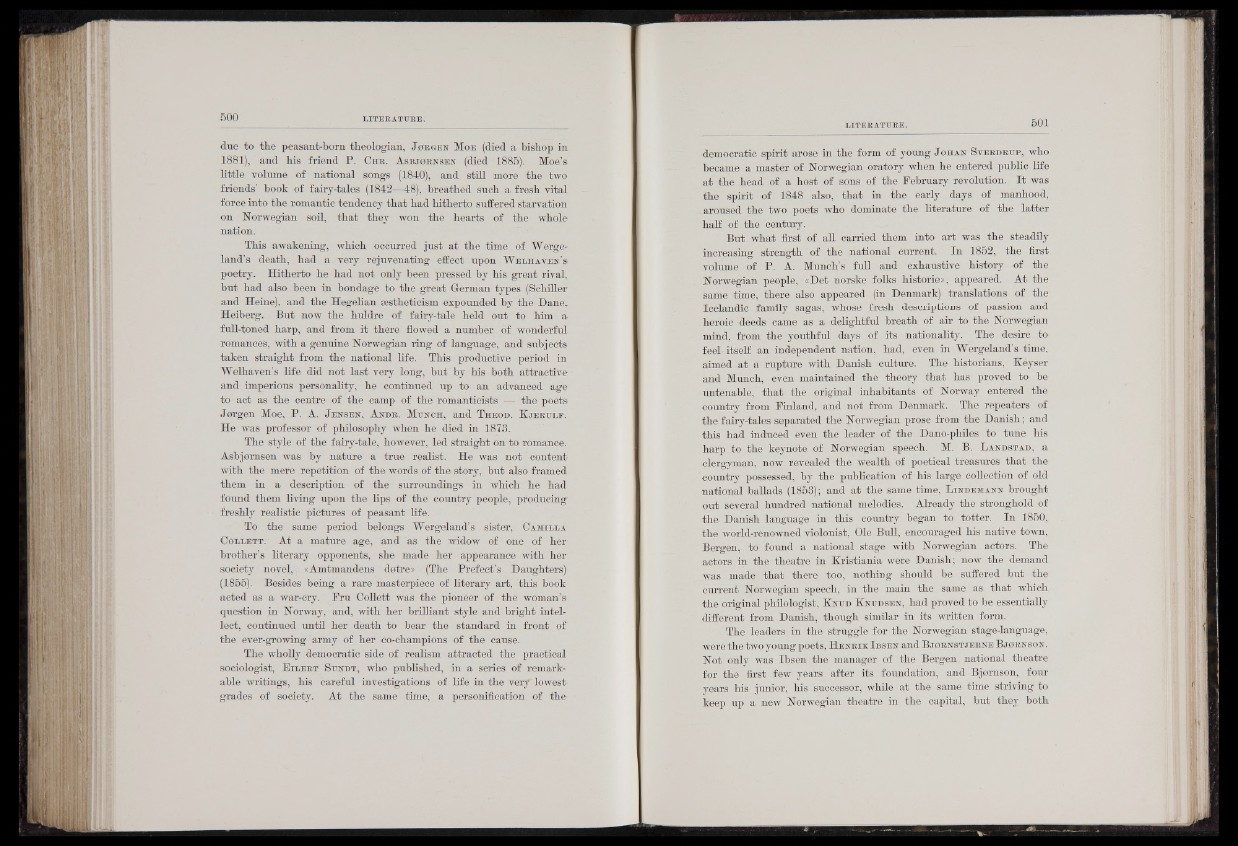
due to t ie peasant-born theologian, J o r g e s M o e (died a bishop in
1881), and his friend P. Chr. A s b j o r n s e n (died 1885). Moe’s
little volume of national songs (1840), and still more the two
friends’ book of fairy-tales (1842—48), breathed such a fresh vital
force into the romantic tendency that had hitherto suffered starvation
on Norwegian soil, that they won the hearts of the whole
nation.
This awakening, which occurred just at the time of Werge-
land’s death, had a very rejuvenating effect upon W e l h a v e n ’s
poetry. Hitherto he had not only been pressed by his great rival,
but had also been in bondage to the great German types (Schiller
and Heine), and the Hegelian sestheticism expounded by the Dane,.
Heiberg. But now the huldre of fairy-tale held out to him a
full-toned harp, and from it there flowed a number of wonderful
romances, with a genuine Norwegian ring of language, and subjects
taken straight from the national life. This productive period in
Welhaven’s life did not last very long, but by his both attractive
and imperious personality, he continued up to an advanced age
to act as the centre of the camp of the romanticists -5 the poets
Jurgen Moe, P. A. J e n s e n , A n d r . M u n c h , and T h e o d . K j e r u l f .
He was professor of philosophy when he died in 1873.
The style of the fairy-tale, however, led straight on to romance.
Asbjumsen was by nature a true realist. He was n o t" content
with the mere repetition of the words of the story, but also framed
them in a description of the surroundings in which he had
found them living upon the lips of the country people, producing
freshly realistic pictures of peasant life.
To the same period belongs Wergeland’s sister, C a m i l l a
C o l l e t t . At a mature age, and as the widow of one of her
brother’s literary opponents, she made her appearance with her
society novel, > «Amtmandens dotre» (The Prefect’s Daughters)'
(1855). Besides being a rare masterpiece of literary art, this book
acted as a war-cry. Fru Collett was the pioneer of the woman’s-
question in Norway, and, with her brilliant style and bright intellect,
continued until her death to bear the standard in front of
the ever-growing army of her co-champions of the cause.
The wholly democratic side of realism attracted the practical
sociologist, E i l e r t S u n d t , who published, in a series of remarkable
writings, his careful investigations of life in the very lowest
grades of society. At the same time, a personification of the=
democratic spirit arose in the form of young J o h a n S v e r d r u p , who
became a master of Norwegian oratory when he entered public life
at the head of a host of sons of the February revolution. I t was
the spirit of 1848 also, that in the early days of manhood,
aroused the two poets who dominate the literature of the latter
half of the century.
But what first of all carried them into art was the steadily
increasing strength of the national current. In 1852, the first
volume of P. A. Munch’s full and exhaustive history of the
Norwegian people, «Det norske folks historie», appeared. At the
same time, there also appeared (in Denmark) translations of the
Icelandic family sagas, whose fresh descriptions of passion and
heroic deeds came as a delightful breath of air to the Norwegian
mind, from the youthful days of its nationality. The desire to
feel itself an independent nation, had, even in Wergeland’s time,
aimed .at a rupture with Danish culture. The historians, Keyser
and Munch, even maintained the theory that has proved to be
untenable, that the original inhabitants of Norway entered the
country from Finland, and not from Denmark. The repeaters of
the fairy-tales separated the Norwegian prose from the Danish; and
this had induced even the leader of the Dano-philes to time his
harp to the keynote of Norwegian speech. M. B. L a n d s t a d , a
clergyman, now revealed the wealth of poetical treasures that the
country possessed, by the publication of his large collection of old
national ballads (1853); and at the same time, L i n d e m a n n brought
out several hundred national melodies. Already the stronghold of
the Danish language in this country began to totter. In 1850,
the world-renowned violonist, Ole Bull, encouraged his native town,
Bergen, to found a national stage with Norwegian actors. The
actors in the theatre in Kristiania were Danish; now the demand
was made that there too, nothing should be suffered but the
current Norwegian speech, in the main the same as that which
the original philologist, K n u d K n u d s e n , had proved to be essentially
different from Danish, though similar in its written form.
The leaders in the struggle for the Norwegian stage-language,
were the two young poets, H e n r i k I b s e n and B j o r n s t j e r n e B j o r n s o n .
Not only was Ibsen the manager of the Bergen, national theatre
for the first few years after its foundation, and Bjornson, four
years his junior, his successor, while at the same time striving to
keep up a new Norwegian theatre in the capital, but they both